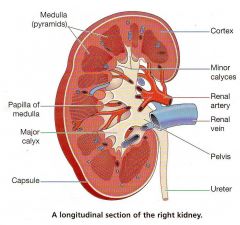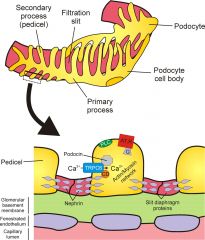![]()
![]()
![]()
Use LEFT and RIGHT arrow keys to navigate between flashcards;
Use UP and DOWN arrow keys to flip the card;
H to show hint;
A reads text to speech;
20 Cards in this Set
- Front
- Back
|
Homeostasis describes the various mechanisms by which the body achieves a constant internal environment. These mechanisms: -thermoregulation -control of blood sugar levels -osmoregulatory function of kidney Complex chemical reactions occurring in all living cells produce waste products- have to be |
eliminated from body by EXCRETION. -Mammals, main organ of EXCRETION is kidney, removes waste product, urea. -Kidney regulates balance of water + dissolved solutes in blood -Organisms living in different environments- those living in desert, have adapted to conserve water |
|
|
-maintenance of constant environment= homeostasis -internal environment made up of tissue fluids that bathe cells, supplying nutrients and removing waste Maintaining these fluids at optimum level protects cells from changes in external environment |
Cells can function normally despite external changes. Changes in pH, temperature and water potential occur. These changes fluctuate around a set point, homeostasis- ability to return to that set point. Homeostasis uses a negative feedback system |
|
|
Control of any self-regulating system, many stages involved: -set point, desired level or NORM at which system operates -receptor detects any deviation from set point -receptor sends instructions to a co-ordinator |
co-ordinator communicates with 1 or more effectors which carry out corrective procedures -Once correction is made and factor returned to normal, information fed back to detector which then switches off. -In most biological control systems, co-ordinator is no longer alerted to deviation from normal- negative feedback |
|
|
Feedback loop- negative feedback if it turns system off Input- Change to system Receptor- measures level of a factor Control unit- operational information is stored here and used to co-ordinate effectors |
Effectors- bring about changes to system to return it to set point Output- system returned to set point - LINKS BACK TO FEEDBACK LOOP The kidney: -Removes nitrogenous metabolic waste from body |
|
|
-Osmoregulation, balance of water and dissolved solutes is regulated. UREA- poisonous chemical made by LIVER. too much protein in diet- any excess broken down. Amino acids, which make up a protein, are deaminated in LIVER. These reactions produce AMMONIA- quickly converted to UREA (less toxic) |
Urea released into blood, travels around body until removed by kidneys . Deamination- breakdown of excess amino acids in LIVER, by removal of amine group. Urea produced as final product. Structure of Kidney: -humans have 2 kidneys -main organs filter waste products from blood |
|
|
Each kidney receives blood from a renal ARTERY and returns blood to GENREAL CIRCULATION via renal VEIN. A narrow tube- ureter, carries urine from kidney to BLADDER. The kidney is covered by a tough capsule. 3 main areas in a kidney: -CORTEX, MEDULLA and region where URETER joins PELVIS |
Microscopic section through a kidney- thousands of minute tubes- nephrons. Blood vessels in close association with nephrons. BLOOD SUPPLY to nephron begins- afferent arteriole serving the glomerulus. From glomerulus blood is carried by efferent arteriole to 2 other capillary structures: |
|
|
-a capillary network serving PCT and DCT - a capillary network running beside loop of Henle-VASA RECTA. Unlike carbohydrates and fats, PROTEIN can't be stored. |

|
|
|
Structure of Bowman's Capsule: =afferent arteriole (WIDE) -efferent arteriole (narrower) -SQUAMOUS EPITHELIAL CELLS of renal capsule -capillaries of glomerulus -capillary- showing pores -basement membrane |
-cells of PCT -path of filtrate from blood plasma to CAPSULE LUMEN Kidney- cortex, medulla, pelvis, ureter, capsule and nephron- one of a million |
|

|

|
|
|
Ultrafiltration: Filtration under pressure separates small soluble molecules from blood plasma. Small soluble molecules- water, glucose, urea + salts filtered from capillaries of glomerulus into Bowman's Capsule. Blood entering glomerulus separated from space inside Bowman's Capsule by 2 cell layers |
and a BASEMENT MEMBRANE. Rate at which fluid passes from blood in glomerular capillaries into Bowman's Capsule- glomerular filtration rate. This rate is rapid and is determined by difference in water potential between the 2 areas. NET EFFECT of higher pressure in capillary and lower solute concentration in B Capsule
|
|
|
is that fluid moves out of capillary and into lumen of capsule. Basement membrane of capillary forms selective barrier between blood and nephron, acts as a molecular sieve. -first cell layer is wall of capillary, single layer of cells contains many gaps |
-basement membrane between 2 cell layers acts as a molecular filter -second cell layer makes up wall of B Capsule, EPITHELIAL CELLS in this layer are podocytes. Most pressure forcing molecules through filter comes from HYDROSTATIC pressure of blood in glomerular capillaries |
|
|
-Pressure amplified by pressure in capsule produced by narrow efferent vessels + water potential in blood produced by colloidal plasma proteins. Glomerular pressure can be altered by changes in diameter of efferent + afferent arterioles entering + leaving glomerulus.
|
-Using electron microscope allowed scientists to work out process of ULTRAFILTRATION -The sieve action allows smaller sized molecules to pass through but cells and blood proteins retain in capillaries. High blood pressure maintained in glomerulus by contraction of heart, afferent arteriole, wider diameter than efferent |
|
|
arteriole and large SA of capillaries of glomerulus. Selective Reabsorption- process by which useful products- GLUCOSE and salts are reabsorbed back into blood as filtrate flows along NEPHRON.
|
-ALL glucose and most of water and salt (sodium and chloride ions) are reabsorbed in PCT. Cells in wall of TUBULE are adapted by: -Microvilli, large SA for absorption -Numerous mitochondria, ATP for active transport of glucose and salts. -WATER reabsorbed passively by OSMOSIS following transport of salt |
|
|
-SMALL quantities of WATER and salt are reabsorbed in DCT -Most of remaining water is reabsorbed in collecting duct, via mechanism which involves loop of Henle. Reabsorption by active transport and diffusion, endothelial cell, lumen of blood capillary (cells from wall of PCT) |
Reabsorption of water and role of loop of Henle and collecting duct: -numerous loops of Henle collectively CONCENTRATE salts in tissue fluid of medulla of kidney-high concentration of salt causes an osmotic flow of water OUT of collecting ducts, concentrating urine and making it hypertonic to blood |
|
|
-first part of loop of Henle- descending limb and second part of loop is Ascending limb. Ascending limb- walls are impermeable to water, cells in walls actively transport Na+ and CI- ions out of fluid in tubule and into tissue fluid between limbs, producing an area of low water potential |
Walls of descending limb are permeable to water. As fluid flows down tubule, water passes out, by OSMOSIS, into region of low water potential NA+ and CI- ions diffuse into descending limb, as fluid flows down descending limb it contains progressively less water and solution more concentrated at bottom of loop
|
|
|
As NA+ and CI- ions diffuse across. Concentrated fluid begins to flow up ascending limb, having 2 limbs of loop running side by side, filtrate flows one way up in ascending limb and down in descending limb, allowing a maximum concentration to be built up both inside and outside the tube at the apex of the loop. Counter-current multiplier
|
The fluid flowing up ascending limb becomes more dilute as it LOSES sodium and chloride ions and so has a higher water potential. When fluid reaches collecting duct it runs back into medulla passing through the region of low water potential. Water passes out of collecting duct by OSMOSIS towards this region
|
|
|
WATER passes into blood capillaries (vasa recta) surrounding loop of Henle and into general circulation. Materials in blood include blood cells, plasma proteins, glucose, salts, water, and urea. Blood cells + plasma proteins remain in blood, leaves urine- made up of urea with some water and salts, which passes to bladder (from ureter)
|
Osmoregulation- homeostatic control of body water. VASA RECTA- capillaries surrounding loops in medulla have a dual role, to deliver nutrients to cells of medulla + carry water reabsorbed from kidney. Counter-current m end result is a low water potential at APEX of loop.
|
|
|
Collectively, large number of loops create a region of low water potential in medulla + as collecting ducts carrying urine pass through medulla, water is drawn out by OSMOSIS resulting in more concentrated urine, acts as a fine control of osmoregulation.
|
Ascending limb- Sodium ions actively pumped out of this region. Osmoregulation: -Mammals have to maintain a balance between water gain and water loss. Humans gain most water from drinking + food, most water lost as urine, other losses from sweating, loss in faeces, keeping exchange surfaces moist, keeping constant body temperature. |
|
|
|
|
|
|
|
|

